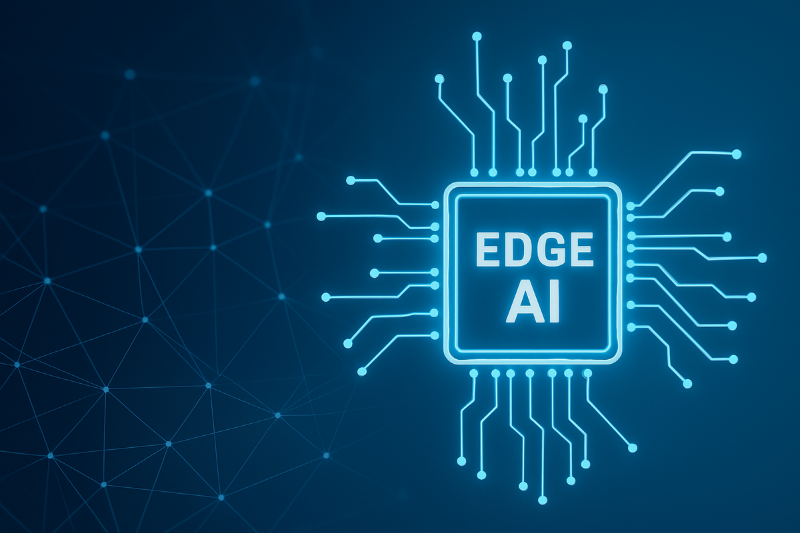1. Introduction: The Unstoppable Rise of AI at the Edge
We’re witnessing a fundamental shift in how artificial intelligence is deployed and utilized. While cloud-based AI continues to play a crucial role, there’s an undeniable movement toward running AI models directly where data is generated—on smartphones, IoT devices, factory floors, and local servers. This paradigm, known as edge computing, is transforming industries by bringing intelligence closer to the action.
However, achieving high inference efficiency at the edge presents a significant challenge. How do organizations maintain peak performance while controlling costs? How do they manage complex GPU infrastructure across distributed locations? This is where intelligent resource management becomes critical. WhaleFlux emerges as an essential tool for enterprises managing the sophisticated GPU infrastructure that powers efficient edge AI platforms, providing the missing layer between hardware capability and operational excellence.
2. The Pillars of an Efficient AI Inference Edge Platform
Building an effective edge AI platform requires balancing four fundamental pillars that define success in real-world deployments:
Low Latency is perhaps the most critical requirement for many edge applications. In autonomous vehicles, industrial robotics, and real-time safety systems, inference must happen in milliseconds. The entire pipeline—from sensor data capture to processed output—must operate with minimal delay to enable immediate action. This eliminates the round-trip time to cloud data centers and ensures responsive, real-time decision making.
High Throughput addresses the scale of operations. Many edge applications involve processing multiple data streams simultaneously—think of a smart city intersection analyzing video from a dozen cameras, or a manufacturing facility monitoring hundreds of products on an assembly line. The platform must handle massive numbers of inferences per second without creating bottlenecks or dropping critical data.
Power Efficiency becomes increasingly important in edge environments where thermal management and power constraints are real concerns. Unlike climate-controlled data centers, edge devices often operate in confined spaces with limited cooling and power budgets. Maximizing computations per watt isn’t just about saving electricity—it’s about ensuring reliable operation within physical constraints.
Cost-Effectiveness ties everything together by balancing performance with total cost of ownership (TCO). This includes not just the initial hardware investment, but ongoing operational expenses, maintenance costs, and the efficiency of resource utilization. An efficient platform delivers maximum value for every dollar spent across the entire infrastructure lifecycle.
3. The Hardware Backbone: Choosing the Right NVIDIA GPUs for Edge Inference
Selecting the appropriate hardware foundation is crucial for edge AI success. The “best” platform varies depending on specific use cases and how they balance the four efficiency pillars. NVIDIA’s GPU portfolio offers tailored solutions for different edge scenarios:
Tier 1: Data Center-Grade Edge Power (NVIDIA H100/H200)
These high-performance GPUs are designed for centralized edge data centers that aggregate and process data from multiple edge locations. They’re ideal for batch processing complex models, handling massive inference workloads, and serving as the computational backbone for demanding edge networks. The H100 and H200 excel in scenarios where raw processing power takes priority over power efficiency, making them perfect for telecom edge nodes, regional processing centers, and applications requiring the highest levels of performance.
Tier 2: The Versatile Workhorse (NVIDIA A100)
Striking an optimal balance between performance and efficiency, the A100 serves as the ideal solution for high-throughput edge servers. Its versatility makes it well-suited for smart city video analysis, healthcare imaging applications, and telecom edge nodes where consistent performance and reliability are paramount. The A100 delivers data-center-level capabilities in edge-appropriate form factors, providing the perfect blend of computational power and practical deployment characteristics.
Tier 3: Accessible High Performance (NVIDIA RTX 4090)
For prototyping, development, testing, and cost-sensitive deployments, the RTX 4090 offers remarkable performance at an accessible price point. It’s perfect for research institutions, development teams, and specialized edge applications where budget constraints exist but high performance is still required. The 4090 enables organizations to build sophisticated edge AI capabilities without the premium cost associated with data-center-grade hardware.
4. Beyond Hardware: How WhaleFlux Optimizes Your Entire Edge Inference Stack
While selecting the right NVIDIA GPUs provides the essential foundation, the true potential of an edge AI platform is realized through intelligent resource management. This is where WhaleFluxtransforms good hardware into an exceptional edge inference ecosystem.
WhaleFlux serves as the intelligent GPU resource management platform that maximizes the efficiency of your entire edge inference infrastructure. It acts as the central nervous system for your distributed GPU resources, ensuring optimal performance across all your edge locations.
The platform delivers three key benefits that directly address the core challenges of edge AI deployment:
Maximized Utilization is achieved through WhaleFlux’s dynamic workload allocation across clusters of mixed NVIDIA GPUs. The system continuously monitors inference demands and intelligently distributes processing across available H100, A100, and RTX 4090 resources. This prevents resource idling during low-usage periods and ensures adequate capacity during peak demand, significantly improving overall hardware utilization rates.
Reduced Operational Costs come from WhaleFlux’s optimization of GPU usage across your entire edge fleet. By eliminating wasted capacity and ensuring efficient resource allocation, organizations can achieve the same inference throughput with fewer GPUs, directly lowering cloud and infrastructure expenses. The platform’s intelligent scheduling capabilities mean you’re getting maximum value from every GPU in your deployment.
Simplified Model Deployment is accelerated and stabilized through WhaleFlux’s consistent management framework. The platform streamlines the rollout of new AI models to edge locations, ensuring version consistency and operational reliability across all nodes. This eliminates the “it worked in development” problem that often plagues edge AI deployments.
For organizations seeking flexibility in their edge deployments, WhaleFlux provides access to NVIDIA GPU power through both purchase and rental models. With monthly minimum commitments, businesses can scale their edge capabilities without long-term capital investment, perfect for pilot projects, seasonal demands, or gradual infrastructure expansion.
5. Real-World Applications: Efficient Inference in Action
The theoretical benefits of efficient edge AI become concrete when examining real-world implementations across different industries:
In Smart Cities, traffic management systems demonstrate the power of optimized edge inference. A100-powered edge servers process video feeds from dozens of intersection cameras in real-time, analyzing vehicle flow, detecting incidents, and optimizing traffic light timing. When managed by WhaleFlux, these systems achieve optimal traffic flow analysis by dynamically allocating computational resources based on traffic patterns—increasing processing power during rush hours and conserving energy during lighter periods.
Industrial Automation showcases the importance of reliable, low-latency inference. Manufacturing facilities deploy RTX 4090-based systems for real-time visual inspection on production lines. These systems identify defects, verify assembly completeness, and ensure quality control with millisecond-level response times. The integration with WhaleFlux ensures consistent performance across multiple production lines and enables rapid deployment of updated inspection models without disrupting operations.
Autonomous Vehicles represent the ultimate test of edge inference efficiency. These systems process massive amounts of sensor data from LiDAR, cameras, and radar in near-real-time, requiring robust, low-latency inference platforms. The computational demands vary dramatically based on driving conditions—navigating a busy urban intersection requires significantly more processing than highway driving. Platforms managed by WhaleFlux can dynamically allocate resources to meet these fluctuating demands while maintaining the reliability required for safety-critical applications.
6. Building Your Optimal Edge AI Platform: A Practical Guide
Implementing an efficient edge AI platform requires a structured approach. Follow these steps to ensure success:
Step 1: Profile your AI model’s requirements thoroughly before selecting hardware. Document the specific latency needs for your application—is 10 milliseconds acceptable, or do you need 2 milliseconds? Measure the throughput requirements—how many inferences per second must the system handle? Determine the precision needs—can you use quantized models, or do you require full precision? This profiling forms the foundation for all subsequent decisions.
Step 2: Select the appropriate NVIDIA GPU tier based on your profiling results. Match your latency, throughput, and precision requirements to the GPU capabilities outlined in Section 3. Consider not just current needs but anticipated future requirements, and factor in environmental constraints like power availability and thermal management.
Step 3: Integrate WhaleFlux from the beginning of your deployment. Rather than treating resource management as an afterthought, make it a core component of your architecture. The platform will manage and orchestrate your GPU resources efficiently from day one, providing immediate benefits in utilization and simplifying ongoing operations.
Step 4: Establish metrics for monitoring performance, cost, and efficiency. Define key performance indicators (KPIs) around inference latency, throughput rates, GPU utilization percentages, and cost per inference. Regularly review these metrics to identify optimization opportunities and validate that your platform continues to meet operational requirements.
7. Conclusion: Efficiency is the Key to Edge AI Success
The journey to building the best edge platform for AI inference efficiency reveals a crucial insight: success depends on the seamless integration of purpose-built NVIDIA hardware and intelligent management software. The most powerful GPUs alone cannot guarantee optimal performance—they require sophisticated orchestration to unlock their full potential.
WhaleFlux emerges as the key to unlocking true inference efficiency, transforming GPU clusters from mere cost centers into strategic, high-performance assets. By maximizing utilization, reducing operational costs, and simplifying deployment, the platform ensures that organizations can scale their edge AI capabilities efficiently and reliably.
As edge AI continues to evolve and expand into new applications, the organizations that prioritize efficiency will gain significant competitive advantages. They’ll deliver better user experiences, operate more sustainably, and achieve higher returns on their technology investments.
Now is the time to evaluate your edge AI strategy and consider how WhaleFlux can help you achieve superior efficiency and lower total cost of ownership. The future of intelligent edge computing is here—ensure your organization is positioned to capitalize on its full potential.

